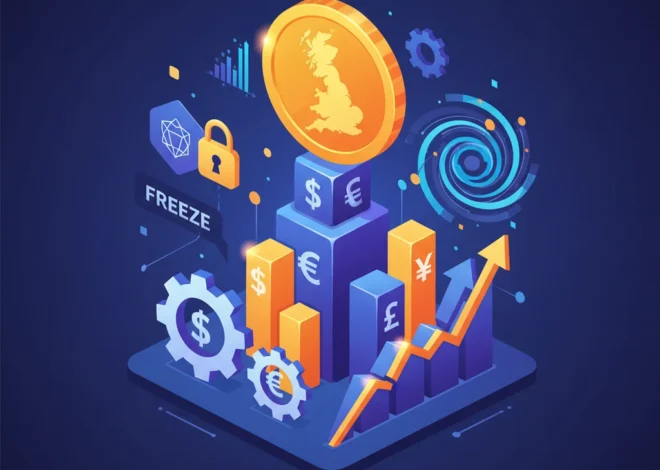
The Stealth Tax Squeeze: Why One in Four Britons Are on a Collision Course with Higher Taxes
In the complex world of national finance and personal economics, few things are as certain as death and taxes. But what happens when the tax system itself begins to shift silently, catching millions of unsuspecting earners in its net? A recent, eye-opening report from the Institute for Fiscal Studies (IFS) reveals a startling trend: if UK tax thresholds remain frozen, a staggering one in four UK adults will be paying the higher or additional rate of income tax by 2027-28. This represents a seismic shift in the nation’s fiscal landscape, transforming a tax bracket once reserved for the highest earners into a reality for a significant portion of the professional middle class.
This phenomenon, often dubbed a “stealth tax,” is not the result of a dramatic budget announcement or a new piece of legislation. Instead, it’s the quiet, relentless effect of a policy decision to freeze tax thresholds in a high-inflation environment. As we delve into the data, the implications for personal wealth, the broader economy, and investment strategies become profoundly clear. This isn’t just a story about numbers; it’s about the changing financial reality for millions of households across the United Kingdom.
The Rising Tide: Unpacking the IFS Projections
The research, highlighted by the Financial Times, paints a stark picture of a rapidly expanding tax base. The core issue lies in the six-year freeze on income tax thresholds, a policy set to continue until 2028. While wages and salaries have risen—pushed upwards by inflation—the goalposts for what constitutes a “high” income have remained bolted to the ground.
The result is a powerful fiscal drag that pulls more and more people over the line into higher tax brackets. Let’s look at the numbers to understand the scale of this change.
The following table illustrates the dramatic increase in the proportion of the UK adult population paying higher rates of income tax over time, based on the IFS analysis.
| Time Period | Proportion of UK Adults Paying Higher/Additional Rate Tax |
|---|---|
| Early 1990s | 3.5% (1 in 30) |
| A Decade Ago (approx. 2014) | 10% (1 in 10) |
| By 2027-28 (Projected) | 25% (1 in 4) |
This isn’t a gradual evolution; it’s a rapid acceleration. The number of higher-rate taxpayers is projected to reach 7.8 million, a figure that has more than doubled in less than two decades. This policy is a significant revenue generator for the Treasury, with the IFS estimating that extending the freezes beyond 2028 could raise an additional £8.3 billion in the 2029-30 fiscal year alone. But for individuals, it means a tangible reduction in their take-home pay and purchasing power.
The Billion Deal That Vanished: How Geopolitics Just Redrew the Map for Global Finance
The Mechanics of a Stealth Tax: Understanding Fiscal Drag
To fully grasp the situation, it’s crucial to understand the economic principle at play: fiscal drag. In a healthy economy, governments typically increase tax thresholds each year in line with inflation. This ensures that people don’t pay more tax simply because their pay has risen to keep pace with the cost of living. Their “real” income (what they can actually buy) hasn’t changed, so their tax burden shouldn’t either.
Fiscal drag occurs when these thresholds are frozen while wages rise. Here’s a simplified breakdown:
- The Threshold Freeze: The higher-rate tax threshold in England, Wales, and Northern Ireland is currently frozen at £50,271.
- Wage Inflation: An employee earning £48,000 receives a 5% pay rise to keep up with inflation, bringing their salary to £50,400.
- The Consequence: Without the freeze, the threshold might have risen to, say, £52,500. The employee would have remained a basic-rate taxpayer. But with the freeze, they are now pushed into the 40% tax bracket, paying a significantly higher rate on the portion of their income above the threshold.
This process effectively increases the government’s tax take without the politically difficult move of explicitly raising tax rates. It’s a subtle but incredibly effective tool for boosting Treasury coffers, fundamentally altering the financial planning landscape for millions who never previously considered themselves “high earners.”
The Ripple Effect: From Household Budgets to the Stock Market
The impact of this fiscal drag extends far beyond individual payslips, creating ripples that affect the entire UK economy. Investors, business leaders, and finance professionals must take note of these interconnected consequences.
Impact on Consumer Spending and the Economy
With less disposable income, millions of households will be forced to cut back on non-essential spending. This directly impacts retail, hospitality, and leisure sectors. For businesses, this means potentially lower revenues and a more cautious consumer base. On a macroeconomic level, suppressed consumer demand can act as a brake on GDP growth, complicating the country’s economic recovery.
Implications for Investing and Wealth Management
The squeeze on disposable income directly affects an individual’s capacity for investing. With less surplus cash at the end of the month, contributions to stocks, funds, and pensions may be reduced. This can have a long-term impact on retirement planning and wealth accumulation. The stock market itself can be affected, as lower retail investor participation and weaker corporate earnings (from reduced consumer spending) can create headwinds for market growth.
The table below shows a hypothetical example of how fiscal drag can impact an individual’s disposable income and, consequently, their potential investment capacity.
| Scenario | Salary | Tax Threshold | Tax Bill (Illustrative) | Change in Investment Capacity |
|---|---|---|---|---|
| Year 1 (No Freeze) | £49,000 | £50,271 | £7,286 (Basic Rate Only) | Baseline |
| Year 2 (Inflation-linked Threshold) | £51,450 (5% rise) | £52,785 (5% rise) | £7,776 (Still Basic Rate) | Maintained in real terms |
| Year 2 (Frozen Threshold) | £51,450 (5% rise) | £50,271 (Frozen) | £8,042 (Higher Rate Kicks In) | Reduced by hundreds of pounds |
Note: Tax calculations are simplified for illustrative purposes.
This shift makes tax-efficient investment strategies more critical than ever. Maximizing contributions to ISAs and SIPPs (Self-Invested Personal Pensions) becomes paramount to shield investment growth from the taxman. The role of financial technology and modern banking platforms in providing accessible tools for budgeting, tax planning, and managing investments will become increasingly vital for the newly minted higher-rate taxpayer.
Wall Street's Warning Bell: Is the US Financial System's Plumbing About to Clog Again?
Navigating the New Fiscal Reality
For individuals and businesses, adapting to this environment requires a proactive approach to financial management. The old rules of thumb may no longer apply when a significant pay rise could result in a minimal increase in take-home pay.
- For Individuals: It’s time for a financial health check. Understand exactly where your income sits relative to the thresholds. Explore salary sacrifice schemes for pension contributions or electric vehicles, which can reduce your taxable income. Financial literacy and proactive planning are your best defenses.
- For Business Leaders: This trend has profound implications for employee compensation and retention. A simple salary increase may be less attractive than it once was. Businesses may need to consider more sophisticated reward packages, including enhanced pension contributions, share options, or other benefits that are more tax-efficient for employees now finding themselves in a higher bracket.
- For Investors: The focus must be on tax efficiency. Beyond ISAs and pensions, investors may need to consider the tax implications of different asset classes. While a niche and high-risk area, some sophisticated investors are exploring how emerging technologies like blockchain could offer alternative, decentralized stores of value, though this complex area of trading requires deep expertise and caution.
The IFS report is more than a forecast; it’s a warning. It signals a fundamental and long-term shift in the UK’s tax landscape. The era of the higher-rate tax bracket being an exclusive club is over. It is rapidly becoming the new normal for a quarter of the adult population.
The Billion-Dollar Blind Spot: Why the McDonald's Harassment Scandal is a Wake-Up Call for Investors
Conclusion: A Tipping Point for UK Taxpayers
The silent march of fiscal drag is reshaping the financial lives of millions in the UK. The IFS’s projections are not a distant possibility but a near-term certainty if current policy remains unchanged. This “stealth tax” squeeze will test the resilience of household finances, challenge business compensation models, and influence the direction of the national economy.
For individuals, investors, and business leaders, awareness is the first step. Understanding the mechanics of this shift is crucial for effective financial planning, protecting wealth, and navigating a landscape where the definition of a “high earner” is changing before our very eyes. The conversation about tax in the UK is no longer just about rates; it’s about the thresholds, and their silent, powerful, and ever-increasing grip.


